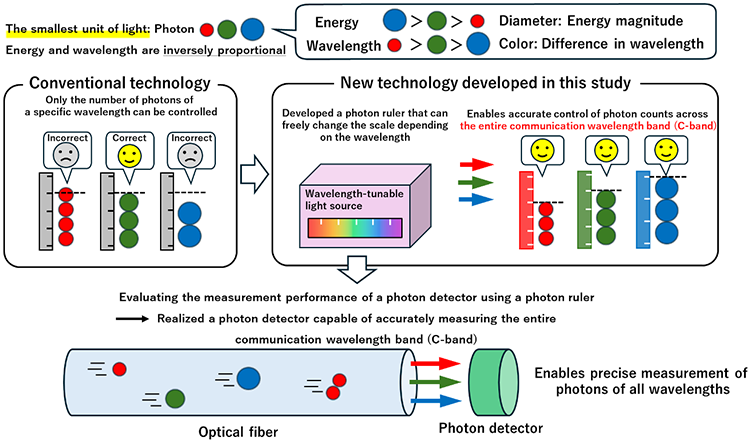―Development of a wavelength-tunable light source for the entire optical communication (C-band) with precise single-photon-level output―
Researchers) JODOI Takeshi, Research Assistant (at the time of the research), FUKUDA Daiji, Prime Senior Researcher, Research Institute for Physical Measurement, TSURUTA Tetsuya, Researcher, Global Research and Development Center for Business by Quantum-AI technology(G-QuAT)
- Developed a new laser light source capable of determining the number of photons across the entire C-band range in a manner traceable to national standards
- Detect photons emitted from the developed light source and accurately evaluate the detector's detection efficiency
- This technology is essential for enhancing the security of high-speed quantum cryptography and the reliability of future optical quantum computers.

Image of a "photon ruler" with freely adjustable scales depending on wavelength
Quantum technologies are expected to significantly transform our lives and society. Among them, applications utilizing photons—the smallest units of light—are attracting worldwide attention from both research and industry. For example, quantum cryptography, which is theoretically considered impossible to eavesdrop on, is a technology that aims to achieve secure communication by exploiting the fact that photons cannot be divided. Furthermore, optical quantum computers, which use the quantum properties of photons to perform complex calculations at high speed, are also under development toward practical application.
To achieve the widespread adoption of these quantum technologies, it is essential to handle photons correctly and accurately measure the number of photons reaching the detector from the light source. However, photons have extremely weak energy, making it very difficult to evaluate the detection performance of photon detectors. Until now, even within the C-band (1530 nm to 1565 nm) used in optical communications, such evaluations were limited to only a narrow range of wavelengths. Whether aiming to accelerate quantum cryptography through wavelength multiplexing or to scale up optical quantum computers, it is necessary to evaluate the performance of photon detectors across the entire C-band spectrum.
Researchers at AIST have developed a wavelength-tunable light source capable of precisely controlling output in single-photon units, covering the C-band (1530 nm to 1565 nm) used in optical communications. A photon is the smallest unit of light (electromagnetic waves) and is one of the fundamental particles, alongside electrons and quarks. By controlling photons with high precision, cutting-edge technologies such as quantum communication and quantum computing can be realized. To achieve this, it is necessary to detect the weak light in the wavelength band used for optical communication at the single-photon level. However, until now, it has not been possible to accurately evaluate the proportion of photons detected by a photon detector across the entire C-band. The main challenge has been the absence of a reliable light source that can provide an exact number of photons at any wavelength within this band—a wavelength-tunable "photon ruler."
In this study, we developed a wavelength-tunable light source (standard quantum light source) traceable to the national standard for laser power. By using this source as a photon ruler, we established a technology to measure the performance of photon detectors with high precision across the entire C-band wavelength range used in optical communication. This technology enables the reliability of optical sensors to be guaranteed at the same precision level as the national standard for laser power, not only for specific wavelengths but also across the entire C-band range. It is expected to enhance the security of quantum cryptography and the precision of optical quantum computers.
Journal: Optics and Laser Technology
Title of paper: Evaluation of Detection Efficiency of a Transition Edge Sensor at C-band Wavelength
Authors: Takeshi Jodoi, Tetsuya Tsuruta, Mauro Rajteri and Daiji Fukuda
DOI:https://doi.org/10.1016/j.optlastec.2025.113414